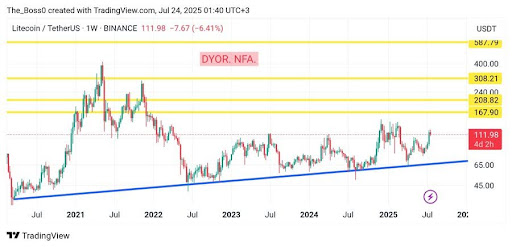
There isn’t a single winner for everyone. The best LTC wallet is the one that matches how you use Litecoin—how often you move coins, how much you keep on hand, and how cautious you are with security. If you prefer to rebalance before you tuck funds away, quick swaps help — try exchange ETH to BTC, then park your LTC in the wallet type that fits your routine. Want some market context first? Check Litecoin price today before you make changes and decide when to move LTC. Use the checklist below to choose LTC wallet settings that match your habits and risk tolerance.

Source: https://www.binance.com/en/price/litecoin
Line chart showing Cardano (ADA) price in USD, with a peak at $0.45 and current price at $0.43 at 06:25 PM EEST, August 6, 2025.
Types of Wallets for LTC
Think of wallets the way you think of accounts: some are great for everyday spending, others for long-term saving. Here’s the lay of the land so you can match a wallet to a job, especially how it handles LTC balances and LTC transactions.
Hardware Wallets
These are small devices that hold your private keys offline (that’s cold storage). Because they’re not permanently connected to the internet, they’re much harder to attack remotely, perfect for larger LTC balances you don’t touch often. You’ll confirm LTC transactions on the device screen and should store the recovery phrase somewhere safer than your notes app.
Software Wallets
Desktop wallets live on your computer. They’re convenient to frequent transactions and often include extras like an address book, fee controls, and watch-only modes. Since they’re connected (hot wallets), your computer’s hygiene matters: timely OS updates, anti-malware, and strong passwords aren’t optional, especially if you’re doing regular LTC transfers.
Mobile Wallets
Mobile apps for iOS/Android are ideal for day-to-day crypto management, scan a QR, send or receive LTC in seconds, check balances on the go. Enable biometrics and a strong PIN. They’re still hot wallets, so treat your phone like a security device, not just a gadget, particularly if it holds spending LTC.
Key Features to Consider
Before you pick a favorite, run through this quick checklist. It helps you compare wallets on what actually matters for LTC holders.
Security
If you don’t control the keys, you don’t control the coins. Security sits at the top of the list. Aim for a secure LTC wallet that protects keys offline or uses robust device security.
- Private key control: You should receive a 12–24-word seed phrase. No seed, no real control over LTC.
- Backup & recovery: Clear, tested steps for saving and restoring your wallet (try a tiny LTC restore test).
- Open-source/peer review: Transparent code tends to get fixes faster.
- Advanced features: Passphrases, multisig, watch-only mode, and address whitelists add layers of safety for Litecoin.
User Experience
Good UX prevents mistakes. If a wallet is easy to use, you’re less likely to slip up.
- Onboarding: Does it guide you through backup and your first LTC transaction?
- Fees & controls: Adjustable fees, mempool insights, and clear status updates save time and LTC.
- Support & docs: Helpful guides and responsive support are clutch when something feels off.
Compatibility
Pick tools that work with your devices and your habits.
- LTC support: Native Litecoin support with modern address formats (e.g., SegWit) is essential.
- Platforms: Check versions for Windows/macOS/Linux/iOS/Android and any hardware bridges.
- Ecosystem: Integrations (exchanges, hardware), plus easy import/export for smooth LTC workflows.
Top LTC Wallets Reviewed
No hype — just where each option shines and where it doesn’t, so you can choose based on how you actually use LTC. Below are the top wallets for LTC and where each option fits best.
Ledger Nano S Plus / Nano X (Hardware)
Best for: Long-term LTC holders who want serious security and broad asset support.
Pros: Offline key storage, mature ecosystem, straightforward backups, strong track record.
Cons: Costs money; you must safeguard the device; firmware updates need your attention.
Tip: Always verify the receive address on the device screen before sending Litecoin.
Trezor Model T / Trezor One (Hardware)
Best for: Fans of open-source firmware and transparent security practices.
Pros: Open design, solid recovery flow, LTC support, clear signing steps.
Cons: Also paid hardware; beginners may need a short learning curve.
Tip: Add a passphrase (an extra word to your seed) to a meaningful security bump.
Electrum-LTC / Litecoin Core / Exodus (Software & Mobile)
Best for:
- Electrum-LTC: Power users who want speed and precise fee control; supports watch-only.
- Litecoin Core: Maximum control and privacy via full-node validation.
- Exodus (Desktop/Mobile): Polished interface and quick setup for newcomers.
Pros:
- Electrum-LTC: Lightweight, fast, granular controls.
- Litecoin Core: Full verification on your own terms.
- Exodus: Smooth UX, easy portfolio view.
Cons:
- Electrum-LTC: Geared toward experienced users.
- Litecoin Core: Big blockchain download; heavy on resources.
- Exodus: Closed source; you rely on vendor updates.
Tip: Pair a software wallet with hardware: cold storage for LTC savings, a hot wallet to quick LTC moves.
Want a plain-English refresher on how wallets work? Skim: “What Is a Crypto Wallet and How Does It Work” before you commit.
How to Choose the Right Wallet for You
Use this simple rule of thumb: match the tool to the risk and the frequency of use.
- Long-term holding, larger sums: Pick a hardware wallet (cold storage). Back up your seed on paper/steel and store it offline in two places for long-term Litecoin.

Source: https://cryptorank.io/ru/news/feed/80ba0-litecoin-long-term-trendline
Line chart showing XRP price in USD, with a peak at $0.65 and current price at $0.63 at 06:40 PM EEST, August 6, 2025.
- Frequent spending & payments: Go with a mobile wallet that supports biometrics and a strong PIN; keep LTC balances modest.
- Privacy/control first: Litecoin Core (full node) or Electrum-LTC with watch-only and manual fee control.
- Hybrid setup: Most Litecoin on hardware; a smaller hot balance for daily transactions.
Setting Up Your LTC Wallet
Five calm minutes now can save you from loud headaches later. Follow this flow once, then you’re set.
- Download or unbox: Use official sources only.
- Create a new wallet: Write the seed phrase by hand. No screenshots, no cloud notes — protect your LTC.
- Enable security: Strong PIN/biometrics; consider a passphrase if supported.
- Verify receive address: On hardware, check on-device; on software, test with a tiny LTC transfer first.
- Backups: Store the seed in two separate secure locations (a metal plate is even better).
- First transaction: Do a small send/receive to make sure everything works before moving real Litecoin amounts.
Tips for Safe Wallet Usage
Security is a habit. These small steps punch above their weight.
- Seed hygiene: Your seed is the wallet. Never share it; ignore “support agents” asking for it — protect your LTC.
- Stay updated: Keep wallet apps and firmware current to patch vulnerabilities early.
- Device discipline: If possible, use a clean, dedicated device to crypto tasks.
- Safer networks: Avoid public Wi-Fi for transactions; a VPN adds a layer when traveling with Litecoin.
- Double-check sends: Verify the destination address (QR or on-device screen) every time before sending LTC.
- Separate buckets: Small hot wallet to spending; cold storage to LTC savings.
- Quarterly check-up: Confirm backups are readable, test a restore, and update anything outdated.
LTC Wallet Comparison
Short on time? Start here, then dive deeper where it matters to you.
- Maximum security: Hardware (Ledger/Trezor) for storing LTC
- Best UX for beginners: Exodus (desktop/mobile) for first Litecoin steps
- Most control & privacy: Litecoin Core (full node) to LTC power users
- Best for frequent on-the-go use: Reputable mobile wallets with biometrics for Litecoin
- Balanced setup: Hardware + lightweight software (watch-only) for monitoring LTC
Conclusion
There’s no one-size-fits-all best LTC wallet — there’s the best wallet for your habits. For larger, long-term positions, cold storage wins. For everyday sends, a convenient hot wallet keeps things moving. Many people land on a hybrid: hardware for savings, mobile/desktop for daily actions. Before reshuffling funds, check Litecoin price today, keep your seed phrase private and offline, and start with a tiny test.